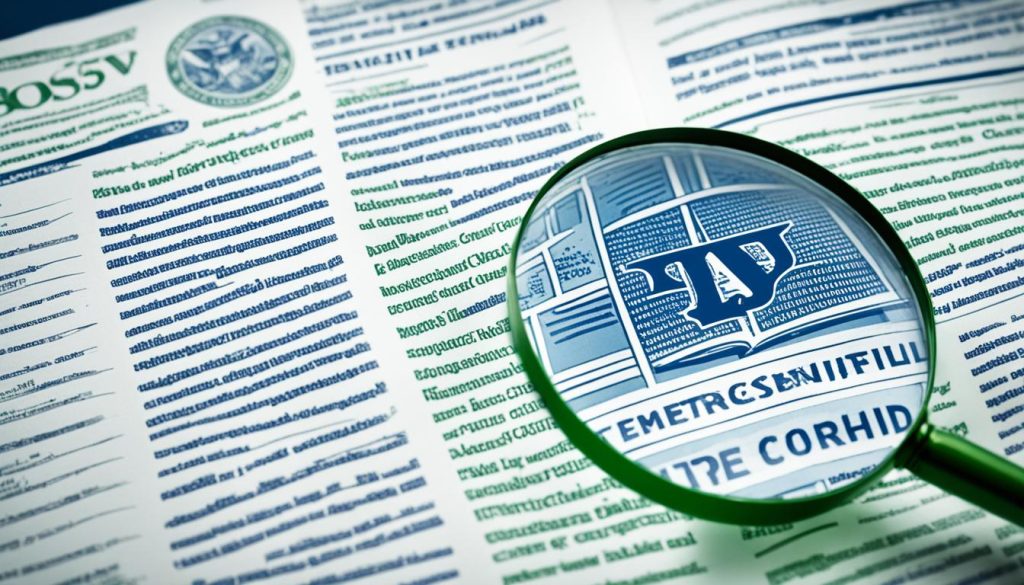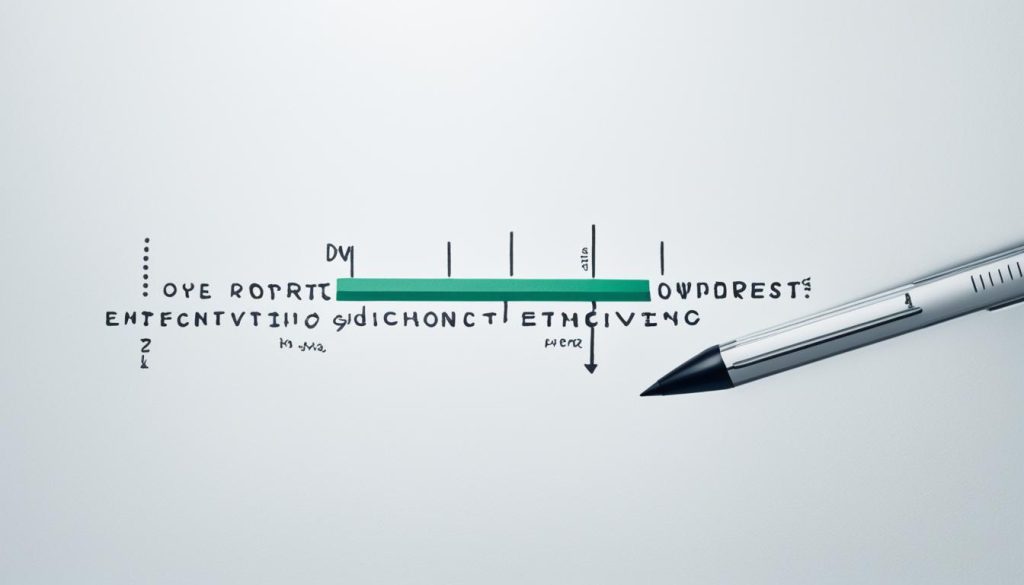How to write an article for website publication
Did you know that website articles have the potential to improve search engine rankings, attract more leads, and increase conversions? Crafting high-quality content for your website can have a significant impact on your online presence and success. In this guide, I will take you through the essential steps of writing articles specifically for website publication. By following these tips, you’ll be able to create engaging and effective articles that resonate with your target audience and bring meaningful results.
Key Takeaways:
- Understanding your target audience is crucial for writing articles that resonate with them.
- Conduct thorough keyword research to optimize your content for search engines.
- Research your topic extensively to provide accurate and reliable information.
- Create a clear outline to ensure a cohesive flow in your articles.
- Write concisely and make your content skimmable to keep readers engaged.
Understand Your Target Audience
When writing articles for website publication, it is essential to understand your target audience. By conducting audience research, you can gain valuable insights into their pain points, needs, and interests. This information will allow you to create content that resonates with your audience and addresses their specific challenges.
One effective way to gather information about your target audience is through qualitative data collection methods such as surveys, focus groups, and interviews. These methods allow you to directly engage with your audience and understand their perspectives. Additionally, monitoring social media groups and online communities where your target audience spends time can provide valuable insights into their preferences and behaviors.
Using the data collected, you can create accurate buyer personas that represent your potential customers. Buyer personas are fictional, generalized representations of your ideal customers, based on real data and research. They help you understand your target audience’s motivations, goals, and pain points, allowing you to tailor your articles to their specific needs and interests.
By addressing your audience’s pain points and providing valuable solutions through your articles, you can effectively engage them and build trust. Understanding your target audience is the first step in creating compelling and impactful website articles.
Key Insights from Audience Research
| Insight | Implication |
|---|---|
| Identify pain points | Create content that addresses these pain points to provide value to your audience. |
| Understand interests | Develop articles that align with your audience’s passions and capture their attention. |
| Uncover needs | Create articles that offer solutions to your audience’s specific needs, positioning yourself as an authority in your niche. |
| Create accurate buyer personas | Tailor your articles to the specific demographics, interests, and challenges of your target audience. |
Choose Relevant Keywords
Keywords are an essential component of successful website article writing. Conducting thorough keyword research allows you to identify the most relevant terms and phrases that accurately describe your topic. By incorporating these keywords strategically throughout your content, you can optimize your articles for search engines and attract more organic traffic to your website.
One effective tool for keyword research is the Keyword Magic Tool. This versatile tool enables you to discover keywords and phrases with high search volume and low keyword difficulty. By targeting these keywords, you can increase your chances of ranking higher in search engine results, improving your visibility and driving more targeted traffic to your website.
It’s also worth considering long-tail keywords, which are longer and more specific keyword phrases. Long-tail keywords are often less competitive, and they can attract higher-quality traffic to your website. By focusing on these targeted keywords, you can connect with individuals who are actively searching for the information or products you provide.
To stay organized and ensure you use your chosen keywords effectively, create a comprehensive keyword list. This list will serve as a handy reference throughout the writing process, allowing you to seamlessly incorporate your target keywords into your articles.
Conduct Thorough Research
Thorough research is the cornerstone of writing informative and authoritative articles. When conducting topic research, it is crucial to rely on reliable sources that uphold the highest standards of credibility and expertise. Trustworthy sources such as academic journals, industry publications, and government reports can provide accurate and reliable information for your articles. By diving deep into your topic and exploring different angles and viewpoints, you can provide a comprehensive perspective that adds value to your readers.
Fact-checking is an essential part of the research process. Double-check the information you gather to ensure accuracy and credibility. Fact-checking helps maintain the integrity of your articles and enhances your reputation as a reliable source of information. It is also important to attribute your sources properly, giving credit where it is due and strengthening the authority of your content.
To further enhance the credibility and expertise of your articles, consider including quotes and interviews from subject matter experts. By incorporating their insights and perspectives, you provide additional validation and support for your claims. These expert opinions can serve as valuable additions to your content, enriching the reader’s experience and establishing your expertise in the field.

| Research Source | Type of Source | Authority |
|---|---|---|
| Research Journal | Academic | High |
| Government Report | Official | High |
| Industry Publication | Professional | Medium |
“`
Table: Examples of reliable research sources for authoritative articles.
Create a Clear Outline
Creating an outline before writing your article is crucial for maintaining a cohesive flow and ensuring that you cover all the crucial points. By starting with an engaging introduction that captivates the reader’s attention, you can set the stage for what’s to come in your article.
Transitioning from the introduction, craft a clear and concise thesis statement that addresses the main question your article aims to answer. This thesis statement serves as the backbone of your article, guiding your writing and giving it direction.
With the foundation set, it’s time to develop your main arguments. Utilize research, case studies, and examples to support your points and provide evidence for your claims. Make sure these arguments flow logically and are presented in a cohesive manner, allowing readers to follow your thought process effortlessly.
As you progress through your article, it’s essential to provide 3-5 takeaways that give readers actionable steps to implement the information you’ve shared. These crucial points should be specific and provide tangible value to your audience, enabling them to apply what they have learned.
Finally, when concluding your article, circle back to your introduction, reinforcing the main theme or idea. Leave your readers inspired and motivated with a powerful closing statement that summarizes the key takeaways and encourages further exploration or action.
By following these steps and creating a clear outline, you can ensure that your article flows smoothly, covers all crucial points, and provides a cohesive reading experience for your audience.
Write Concisely and Skim-Friendly
When it comes to website content writing, concise writing is key to keeping readers engaged. People often skim through online articles, looking for the information they need. To cater to this behavior, it’s crucial to make your content skimmable and easy to digest. Here are some tips to ensure your articles are concise and reader-friendly:
- Use simple and straightforward language. Avoid jargon or complex terms that may confuse readers.
- Avoid excessive marketing language. Provide valuable information without overwhelming readers with promotional content.
- Follow the inverted pyramid style of writing. Start your article with the most important information, then provide supporting details.
- Use headings and subheadings to break up your text. This allows readers to quickly find the information they’re looking for.
- Keep paragraphs short and focused. Long blocks of text can be intimidating and difficult to read on-screen.
- Utilize bulleted lists to highlight important points. This makes it easier for readers to skim and grasp the key takeaways.
- Use sentence case for links. Clearly identify links so that readers know where they will be directed.

By implementing these strategies, you can create website content that is concise, skimmable, and easily understood by your target audience. Remember, the goal is to provide valuable information in a way that is accessible and enjoyable for your readers.
| Benefits of Concise Writing | Examples |
|---|---|
| Improved readability | Readers can quickly scan the content and understand the main points. |
| Higher engagement | Concise writing keeps readers interested and encourages them to read the entire article. |
| Clear communication | By avoiding unnecessary words and jargon, your message becomes more effective and easier to understand. |
| Time-saving | Readers appreciate concise writing as it allows them to consume information more efficiently. |
Follow a Proven Structure
Following a structured framework is key to creating effective web articles. When crafting your article, start with an engaging introduction that captivates the reader’s attention. Connect on a personal level by sharing an anecdote that relates to the topic.
Transition smoothly into your thesis statement, ensuring it is specific and compelling. This statement will serve as the focal point of your article, guiding the reader throughout.
Next, develop your main arguments using well-researched information, case studies, and relevant examples. This substantiates your claims and enhances the credibility of your article. Remember to provide 3-5 takeaways that offer actionable solutions, empowering readers to implement the thesis in their own lives or businesses.
In the conclusion, circle back to your introduction, reinforcing the connection you made at the beginning. Leave the reader inspired and eager to put your ideas into practice. Keep in mind that while this structure provides a solid foundation, feel free to adapt it to your writing style and the unique needs of your target audience.
FAQ
What is an article?
Why is it important to understand your target audience when writing articles for websites?
How can keyword research benefit website article writing?
What role does thorough research play in writing informative articles?
How can creating an outline benefit the writing process?
What are some tips for writing concise and skim-friendly website articles?
What is the importance of following a proven structure when writing web articles?
- How Strategic SEO Drove Growth for a CPAP E-commerce Brand - July 24, 2025
- Top 3 SEO Companies in Toronto: An Analytical Comparison - July 23, 2025
- SEO for Entry Door Services - April 24, 2025





















Post Comment
You must be logged in to post a comment.